I was honored to be invited to speak that the LaSalle University F1rst Congress on Information and Communication Technology Managers. The title of my talk was Open Source Learning Management Systems: Much More Than Free Source Code – here is the abstract.
http://www.dr-chuck.com/csev-blog/000437.html
The talk was great fun – Lluis wanted me to talk more broadly than just Sakai and address teaching and learning in general and give some vision of how I think things will go forward. It is always fun to be given a broad swath. My talk was Tuesday of the week – but I will start upon arrival.
Sunday
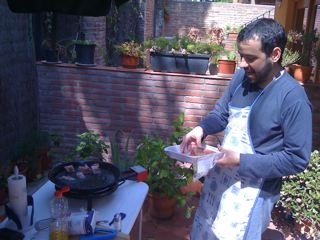
Sunday, I arrived and we went straight to Lluis’ new home to cook Paella – Lluis is a great Paella cook and he shared with me enough secrets so I can make my own Paella back home. It was wonderful – it was a genuine Valencia Paella and it was slightly burned on the bottom – which was very tasty – something you don’t get in restaurants.
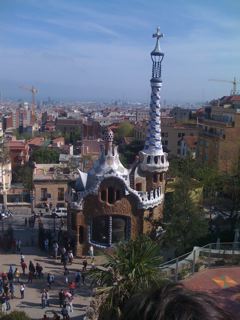
After finishing the Paella – we decided to take a walk to get some coffee – on the way, Lluis asked if I had even been to “Par Guell” – a mountain top park designed by Gaudi. I had not been and so we decided to divert our walk to the top of the mountain. It was very nice – with a wonderful view of Barcelona and a lot of very fun and clever Gaudi touches.
Dinner Sunday night was with the leadership of the Campus Project where we shared a delightful fresh fish dinner baked in salt. Eva, Prof Valverde, Magi, and Francesc – all showed me all the cool things they could do with their iPhones. In my earlier visit to Barcelona – they all really liked the iPhone a lot and now they had become experts in iPhone alteration.
Monday
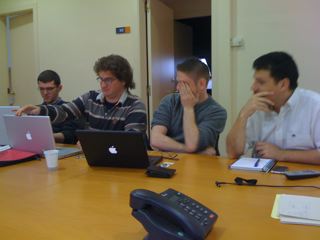 Monday I had an all-day meeting with the Campus Project team. The campus project (www.campusproject.org) is working on building a new pattern for tool creation that will work in both Moodle and Sakai for the Open University of Catelonia. The meeting was excellent and we talked about many things including performance issues and how to solve them as well as a possible way to connect IMS Tool Interoperability.
Monday I had an all-day meeting with the Campus Project team. The campus project (www.campusproject.org) is working on building a new pattern for tool creation that will work in both Moodle and Sakai for the Open University of Catelonia. The meeting was excellent and we talked about many things including performance issues and how to solve them as well as a possible way to connect IMS Tool Interoperability.
Monday night the Campus Project team took me out to dinner. At dinner Marc Alier and I started talking about the Google Summer of Code and how he wanted to make an IMS Tool interoperability Producer for Moodle with his student. It turned out that the deadline for student applications for SOC was that very night in about five hours. So Marc called his student Jordi Piguillem Poch and told him to apply right away. His application made it in and even with a very short timeframe he did a great job on his application.
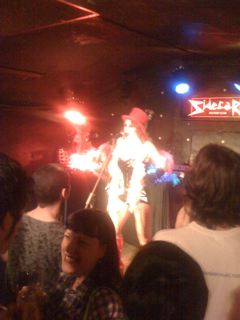
After dinner, we went to a very fun place called Anti-Karaoke (www.antikaraoke.com) at the SideCar club in Plaza Reial in Barcelona. Anti-Karaoke is a combination of heavy-metal Karakoe and Rocky Horror Picture show. You must sing hard rock songs and sing them well and there is no screen with lyrics. There is a Rocky-horror-esque hostess who makes it all very fun. The singers were really talented – it was more like a concert with a different audience member singing every song. I was hopeful when I saw ACDC – the only rock song I know is ACDC’s Who Made Who – but they did not have that song. So I put in a Johnny Cash Song – but then I withdrew it as soon as things started and I realized these people would boo Johnny Cash. Marc Alier put in an ACDC song and since he is a real rocker, he got to sing and did an awesome job on it. His performance inspired me for my own singing debut later in the week in Geneva with the blues band.
Tuesday – Talk Day
Tuesday was my talk which went very well – I followed Martin Dougiamas who came in via Skype. Unfortunately there were technical difficulties that popped up a few times. All in all Martin’s talk was excellent – I had never seen him give the Moodle over view and Roadmap – it was impressive and well thought out. Because of the technical difficulties, I needed to squeeze my 95 slides into less than 1 hour of time – at the same time speaking clearly for an international audience. I actually made it in just over an hour.
I really enjoyed giving the talk – Here is my basic outline:
- Comparing teaching and learning technology to water going from a solid to a liquid and then a gas – focusing on the heat of vaporization and heat of fusion and the need to keep investing even when progress seems slow.
- Talking about how open source leads to open interchange of ideas and how the Sakai and Moodle communities watch each other and learn from each other and how respectful competition is healthy and makes everyone better.
- I presented the University of Michigan’s Student-Centered Learning Approach and discussed some ideas that we have there. I came up with the idea of “learning turbines” to characterize the “two-ring” approach of the UM Medical School.
- I presented a brief review of several user-centered portfolio systems courtesy of University of London Computing Centre (http://portfolio.evaluation.ulcc.ac.uk/) – While none of the three portfolio systems that I looked at (Moodle, Elgg, and Mahara) was perfect, I thought that Mahara (http://www.mahara.org/) was the closest to my thinking about the next generation of user-centered learning systems. I based my opinions on only about 30 minutes with each product – so a grain of salt is necessary on any conclusion I reached.
- Then I moved into discussing how we cannot move to real student-centered learning without first solving functionality mash up – we need to break down the stovepipes of Sakai, Moodle, BlackBoard, etc and give the students and teacher control of their world over their lifetime. I charged us with not tolerating any student-centered learning environment that was not massively extendible. I challenged us not to tolerate another stovepipe and build in functionality mash up form the beginning.
- Then I reviewed IMS Tool Interoperability from a technical perspective and described the demos planned at IMS Learning Impact in Austin and encouraged folks to come.
- Then I reviewed the Google Summer of Code activity and emphasized that its purpose was to work across projects and begin to break down stovepipes that these systems have built up.
- Then I pointed out the efforts of the Campus Project and how they relate to IMS Tool Interoperability.
- Then I mentioned the outstanding work of Cambridge University on MyCamTools as a move towards a more user-centered Sakai. I suggested that this would not make Sakai “user-centered” in my strictest definition – but it was a move toward meeting the needs of the student in a way that was useful to them.
- In my summary I revisited a triangle with the Institution, Teacher, and Student at the three points. I characterized Sakai as strong for the institution, Moodle strong for the teacher, and Facebook/Mahara as strong for the student. But I suggested that in a sense all three projects (and many others) realize their weaknesses and are rapidly evolving to solve all of the problems.
I likened the current state to a transition from the fluid state of water to the gaseous state of water – and that it is an exciting time to be working in technology and education.
I hope the talk will be recorded and published by LaSalle University. I had a good time preparing and doing the talk and there were lots of good questions afterwards.
Tuesday Afternoon – There was a joint workshop on using Sakai and Using Moodle. In times like these I love being a teacher :) I just showed them my courses and how I use Sakai. I showed them how I use CTools at UMichigan to show a hybrid deliver approach – then I used m Etudes account to show how Sakai can work very well in a distance situation with different tools and choices. I showed Melete, Mneme, and JFroum. It all went really well.
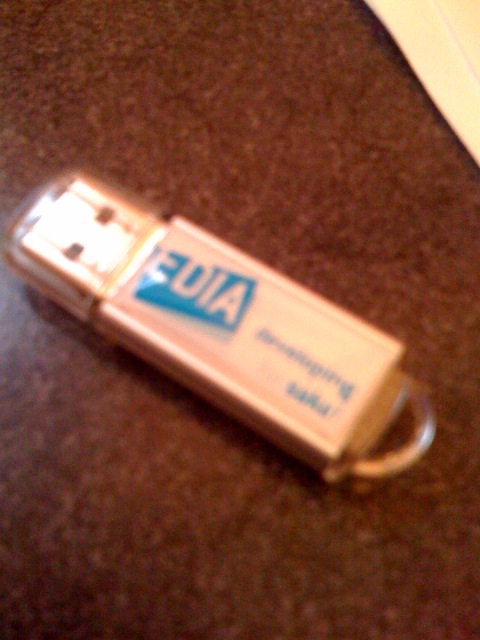
There was a bit of ribbing about how hard Sakai was to install – the first thing the Moodle guy did was hold up a USB stick and do a Moodle install. I felt bad but the Moodle install did not go so well – so he did what I did and demonstrated Moodle funcitonality instead.
While sitting in the back listening to the Moodle demo and rooting around in my backpack, I found the USB stick that I was given by EDIA (http://www.edia.nl/) back almost a year ago in Amsterdam. It was Sakai 2.3 on a USB stick with a special one-click EDIA installer – I had never even tried it but I had carried it around for almost a year. I quietly put it into one of the lab’s laptops and clicked on the EDIA icon. It *ALMOST* worked – it was coming up and then it got some bean error. But that made me think that I need to get something on such a stick with EDIA’s auto-start code so that I am ready for the easy install of Sakai from a stick for my next demo!
Tuesday evening was a wonderful dinner at a beach front restaurant. It was a very relaxing and pleasant evening for me since the talk was finished. The guys from Brazil wanted to go to a disco Tuesday night – but the rest of us were beat and made an early evening of it. So far I had been operating on very little sleep and it seemed like a good idea to get one night’s sleep knowing that Wednesday was my last night in Barcelona. :)
Wednesday
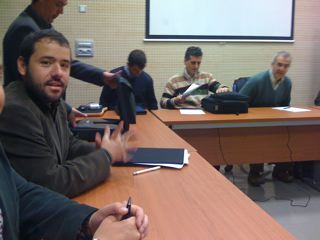
On Wedensday we had the meeting of the Sakai Spain User’s Group. The discussion was excellent – Lluis will have to give me the list of attendees – there were about 25 people there – several schools (Valencia and Ledia) were long-time Sakai adopters who have done much to help develop Sakai, Others were in Pilot, and still others were just curious. We talked of a number of topics:
- How to share expertise and get help when schools run into issues. Valencia and Lleida said they would be glad to help anyone with Sakai.
- How to get a mailing list for the group
- How to have a workshop on installing and administer Sakai. Lleida volunteered to host the workshop. The idea was that the workshop could happen in as short a time as next month. I wished out loud that John Leasia could come to the workshop and promised to see what I could do in that area.
- How to have a Sakai Spain Conference – we talked about a November time frame and thought it would be great fun for Michael and I to both come to that meeting.
- We talked about some transition issues from existing LMS systems – it was mostly about user-comfort issues when going from WebCT to Sakai. This is such a common problem and I wish we were better organized for this. I asked to get a list of the needs. Interestingly, many of the needs were actually usability and portal design – I showed them my Cam tools and everyone’s faces brightened up. Ian Boston might find MyCamTools in production in Spain before it is in production in Cambridge :)
- We talked about making sure folks know about any commercial companies in Spain that are building skills – and share the names of those companies when folks need a bit of out-source help.
- At the end I presented a special gift to the Lledia team thanking them for their strong contribution to the internationalization of Sakai in 2004. Alex Balliste accepted the gift and gave a very short speech :)
All in all, I was totally excited and energized by the meeting and the activity level in Spain. We could easily have 3-4 new schools if we were better organized. Perhaps I will have some time over the summer to get things more organized and provide some help to these schools.
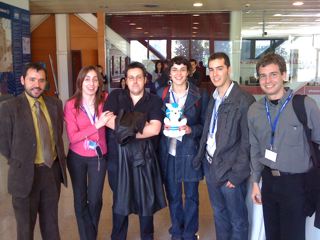
On Wednesday after lunch – we went into a programming festival with the team at Lleida responsible for putting Sakai into production. We covered the following topics:
- Looking at Course Management and coming up with a strategy for building their course management implementation. I was pretty pleased with the documentation of the Course Management API. The README and Javadoc were well done. I do think we need a tool that talks to the Admin interface to CM – I remember some debate about this in the old days – I don’t remember how things were resolved.
- Figuring out how to make the Rutgers Link Tool work in Python/DJango – we made a nice little DJango example that should be available soon – I really wished in my heart that this would have been IMS Tool Interoperability – but now was not the time – and I actually had to learn LinkTool so I can feed the pretty clever thinking that Chuck Hedrick put into Link Tool into the IMS TI specification.
- Figuring how to protect Sakai Web Services with the IP filter code borrowed from the WSRP code (thanks Vishal) – Francesc – tested it nicely and gave me the patch which I will commit when I get a spare breath.
- Looking at how LaSalle wanted to use the Matrix Tool to begin to address Bologna Process Issues – I reviewed how Alfa College (thanks portfolio4u.nl) uses it and we brainstormed on ways to bend some thinking to make use of Matrix tool in its current form and then how to modify Matrix tool is simple ways to accomplish what they needed. Sadly I did not have the experience to give them exact guidance. They were already talking to Beth – perhaps I now can help in the discussion.
All in all it was a good afternoon of coding :)
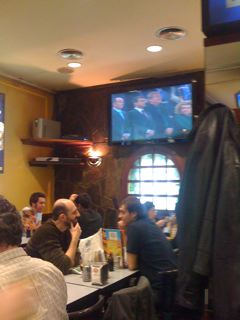
Wednesday evening started out with watching a quarter-final match between Barcelona and a German team in the European playoffs – Lluis had a favorite place with a big screen TV to watch the game so we went there with several LaSalle folks and two of the conference attendees from Brazil. There was much said about Ronaldinho (http://en.wikipedia.org/wiki/Ronaldinho) he is a Brazilian soccer player who was a star for many years for Barcelona – the food was again great – Barcelona won 2-0 and advanced to the semifinals.
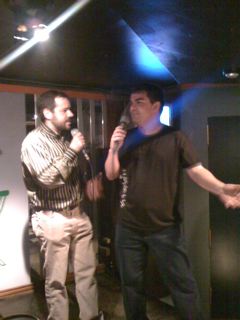
Our next visit was to Conteste Karaoke – this was a place that Lluis spent many fun nights when he was going to school. The place was pretty empty initially – and we sang a few songs – I sang songs I had not prepared just to experiment a bit – we were having a lot of fun.
Then a really large group came in and sat in the front. Lluis told me that it was a bunch of media people who were doing some work and that the main person was Isabel Coixet (http://www.imdb.com/name/nm0170043/) and that she directed a movie called “My Life Without Me” (http://www.imdb.com/title/tt0314412/) – very cool – Lluis must have a photographic memory! The manager of the place had heard me sing “Strangers in the Night Earlier” and came to me and asked me to sing “My Way” as soon as they walked in – I said yes and belted it out (I love that song – it reminds me of Open Source). The group with Isabel had some awesome singers – and they sang some great songs very well.
About half way through the evening a friend of Lluis’ named Anita showed up from the airport – she was an long-time friend of Lluis on her way to Valencia for a wedding and needed to stay at Lluis’s home for the night so she could take a train. She was a good singer so we had even more fun. She lives in Istanbul and Paris – she sang this really cool French song with the perfect French accent. I wanted to sing a Grease song with her – but they only had one song and it was in Spanish and I could not figure out if it was “Hopelessly Devoted to You” or “You are the One That I Want” – folks translated it and I thought it was “You are the one that I want” – so Anita and I went up to sing it. It turned out to be “Hopelessly Devoted to You” and Anita did not know it so I ended up singing the whole song in falsetto :). It as late enough by that time that it was not really that embarrassing for me to do Olivia Newton-John in falsetto.
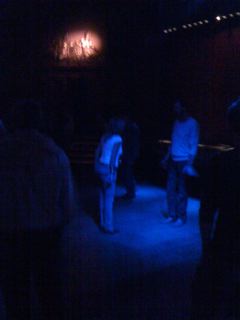
At about 2AM we decided to go – but then Anita mentioned that she had never been to Luz ‘de Gas (http://www.luzdegas.com/) – since it was a few blocks away – we decided to go for *one* drink so she could see it. As usual Lluis knows the manager and owner and bartenders so we get in for free – Anita loves the place – she starts dancing and all the young guys immediately gravitate towards her – Lluis and I are the big brothers for her so she can have a good time. Of course Lluis ended up talking to many people he knew there and we spent a little over an hour.
I get back to the hotel at 4AM and get a bit of sleep – getting up about 7AM to go to the airport for a brief visit to my good friend Steven Goldfarb, a tour of the CERN detector facility, and then my singing debut with a live Blues band. That will be the next story.